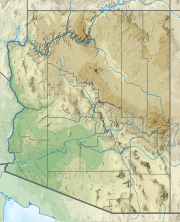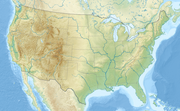Sunset Crater
| Sunset Crater | |
|---|---|
 Sunset Crater from the Cinder Hills | |
| Highest point | |
| Elevation | 8,042 ft (2,451 m) NAVD 88[1] |
| Prominence | 999 ft (304 m)[2] |
| Coordinates | 35°21′52″N 111°30′13″W / 35.36444°N 111.50361°W[1] |
| Geography | |
| Location | Coconino County, Arizona, U.S. |
| Topo map | USGS Sunset Crater East |
| Geology | |
| Rock age | ~950 years |
| Mountain type | Cinder cone[3] |
| Volcanic field | San Francisco volcanic field |
| Last eruption | 1075 ± 25 years[3] |
| Climbing | |
| Easiest route | Hike |
| Sunset Crater Volcano National Monument | |
 | |
| Area | 3,138 acres (12.70 km2)[4] |
| Established | May 26, 1930 |
| Visitors | 104,583 (in 2018)[5] |
| Governing body | National Park Service |
| Website | Sunset Crater Volcano National Monument |
Sunset Crater is a cinder cone located north of Flagstaff in the U.S. state of Arizona. The crater is within the Sunset Crater Volcano National Monument.
Sunset Crater is the youngest in a string of volcanoes (the San Francisco volcanic field) that is related to the nearby San Francisco Peaks.[6]
Formation
[edit]The date of the eruptions that formed the 340-meter-high cone (1,120 ft) was initially derived from tree-ring dates, suggesting the eruption began between the growing seasons of AD 1064–1065.[7] However, more recent geologic and archaeological evidence places the eruption around AD 1085.[8] The largest vent of the eruption, Sunset Crater itself, was the source of the Bonito and Kana-a lava flows that extended about 2.5 kilometers (1.6 mi) northwest and 9.6 kilometers (6 mi) northeast, respectively. Additional vents along a 10-kilometer-long fissure (6.2 mi) extending southeast produced small spatter ramparts and a 6.4-kilometer-long lava flow (4 mi) to the east. The Sunset Crater eruption peaked at VEI 4 (Sub-Plinian), produced a total 0.52 km3 of ejecta,[9] had an eruption column between 20-30km tall[10] and produced a blanket of ash and lapilli covering an area of more than 2,100 square kilometers (810 sq mi), which forced the temporary abandonment of settlements of the local Sinagua people.[3]
The volcano has partially revegetated, with pines and wildflowers. The crater is the namesake for the Sunset Crater Beardtongue (Penstemon clutei). The volcano is monitored by the Yellowstone Volcano Observatory[11] and is classified as a moderate threat.
Damage from hikers forced the National Park Service to close a trail leading to the crater, but a short trail at the base remains.[12]
The hiking trail below the summit skirts the substantial Bonito Lava Flow. This hardened lava is black and appears fresh as it has devastated the forest in its path. The lava flow also created an ice cave or tube that is now closed to the public after a partial collapse.
2015 eruption scare
[edit]On June 5, 2015, a website with satellite images reported steam rising from the crater, leading to fears that Sunset Crater was erupting. The cause of the steam was later determined to be a forest fire, and geologists stated that the volcano was extinct.[13]
Sunset Crater Volcano National Monument
[edit]Sunset Crater Volcano National Monument is a U.S. national monument created to protect Sunset Crater, a cinder cone within the San Francisco Volcanic Field.[14] The monument is managed by the National Park Service in conjunction with nearby Wupatki National Monument. In 1928, a Hollywood film company, Famous Players–Lasky Corporation, planned to detonate large quantities of explosives on the side of Sunset Crater in order to create an avalanche for Zane Grey's motion picture Avalanche.[15] Public outcry over this plan led in part to the proclamation of Sunset Crater Volcano National Monument by President Herbert Hoover in 1930.[16]
A 1-mile (1.6 km), self-guided loop trail is located at the base of Sunset Crater, but hiking to the summit is not permitted. A trail providing access to the summit and crater was closed in 1973 because of excessive erosion caused by hikers.[17] A visitor center is located near the park entrance, 15 miles (24 km) north of Flagstaff, Arizona, along U.S. Highway 89.
In April 2022, the Tunnel Fire burned over the entirety of the monument, though the visitor center was spared.[18][19] In December 2022, 98 acres including the visitor center and administrative facilities were transferred from Coconino National Forest to the national monument.[20]
Climate
[edit]According to the Köppen Climate Classification system, Sunset Crater has a Continental climate, abbreviated "Dsb" on climate maps.
| Climate data for Sunset Crater, Arizona (1991–2020 normals, extremes 1969–present) | |||||||||||||
|---|---|---|---|---|---|---|---|---|---|---|---|---|---|
| Month | Jan | Feb | Mar | Apr | May | Jun | Jul | Aug | Sep | Oct | Nov | Dec | Year |
| Record high °F (°C) | 68 (20) |
70 (21) |
78 (26) |
82 (28) |
91 (33) |
99 (37) |
98 (37) |
97 (36) |
92 (33) |
87 (31) |
74 (23) |
68 (20) |
99 (37) |
| Mean maximum °F (°C) | 57.0 (13.9) |
59.8 (15.4) |
68.1 (20.1) |
75.2 (24.0) |
83.2 (28.4) |
92.8 (33.8) |
93.8 (34.3) |
89.5 (31.9) |
84.9 (29.4) |
77.5 (25.3) |
67.4 (19.7) |
60.8 (16.0) |
94.9 (34.9) |
| Mean daily maximum °F (°C) | 43.9 (6.6) |
46.6 (8.1) |
53.9 (12.2) |
61.1 (16.2) |
70.2 (21.2) |
82.2 (27.9) |
84.2 (29.0) |
80.7 (27.1) |
75.3 (24.1) |
64.6 (18.1) |
53.3 (11.8) |
44.0 (6.7) |
63.3 (17.4) |
| Daily mean °F (°C) | 28.4 (−2.0) |
31.4 (−0.3) |
37.4 (3.0) |
44.1 (6.7) |
51.9 (11.1) |
62.0 (16.7) |
66.6 (19.2) |
63.9 (17.7) |
57.5 (14.2) |
46.3 (7.9) |
35.8 (2.1) |
28.2 (−2.1) |
46.1 (7.9) |
| Mean daily minimum °F (°C) | 12.8 (−10.7) |
16.3 (−8.7) |
21.0 (−6.1) |
27.0 (−2.8) |
33.6 (0.9) |
41.9 (5.5) |
49.0 (9.4) |
47.1 (8.4) |
39.8 (4.3) |
27.9 (−2.3) |
18.4 (−7.6) |
12.4 (−10.9) |
28.9 (−1.7) |
| Mean minimum °F (°C) | −4.1 (−20.1) |
−0.3 (−17.9) |
5.6 (−14.7) |
11.9 (−11.2) |
18.6 (−7.4) |
27.1 (−2.7) |
38.4 (3.6) |
37.7 (3.2) |
26.5 (−3.1) |
15.5 (−9.2) |
2.9 (−16.2) |
−5.1 (−20.6) |
−8.7 (−22.6) |
| Record low °F (°C) | −26 (−32) |
−28 (−33) |
−9 (−23) |
−1 (−18) |
12 (−11) |
16 (−9) |
27 (−3) |
27 (−3) |
12 (−11) |
−5 (−21) |
−12 (−24) |
−25 (−32) |
−28 (−33) |
| Average precipitation inches (mm) | 1.41 (36) |
1.10 (28) |
1.08 (27) |
0.65 (17) |
0.69 (18) |
0.31 (7.9) |
2.65 (67) |
3.45 (88) |
1.72 (44) |
1.39 (35) |
0.87 (22) |
1.72 (44) |
17.04 (433) |
| Average snowfall inches (cm) | 12.2 (31) |
9.4 (24) |
6.1 (15) |
4.2 (11) |
0.8 (2.0) |
0.0 (0.0) |
0.0 (0.0) |
0.0 (0.0) |
0.0 (0.0) |
1.2 (3.0) |
3.5 (8.9) |
11.9 (30) |
49.3 (125) |
| Average precipitation days (≥ 0.01 inch) | 5.6 | 5.8 | 4.9 | 3.8 | 4.1 | 2.3 | 11.9 | 14.2 | 7.6 | 5.0 | 3.6 | 5.8 | 74.6 |
| Average snowy days (≥ 0.1 inch) | 4.1 | 4.4 | 2.7 | 1.8 | 0.4 | 0.0 | 0.0 | 0.0 | 0.0 | 0.4 | 1.9 | 4.4 | 20.1 |
| Source: National Oceanic and Atmospheric Administration[21][22] | |||||||||||||
See also
[edit]References
[edit]- ^ a b "Sunset Crater". NGS Data Sheet. National Geodetic Survey, National Oceanic and Atmospheric Administration, United States Department of Commerce. Retrieved December 23, 2008.
- ^ "Sunset Crater, Arizona". Peakbagger.com. Retrieved August 19, 2016.
- ^ a b c "San Francisco Volcanic Field". Global Volcanism Program. Smithsonian Institution. Retrieved December 23, 2008.
- ^ "Listing of acreage – December 31, 2022" (XLSX). Land Resource Division, National Park Service. (National Park Service Acreage Reports)
- ^ "NPS Annual Recreation Visits Report". National Park Service. Retrieved June 15, 2019.
- ^ Priest, Susan S.; Wendell A. Duffield; Karen Malis-Clark; James W. Hendley II; Peter H. Stauffer (December 21, 2001). "The San Francisco Volcanic Field, Arizona – U.S. Geological Survey Fact Sheet 017-01". United States Geological Survey. Archived from the original on April 21, 2008. Retrieved August 12, 2008.
- ^ Pilles, Peter J. Jr. (1979). "Sunset Crater and the Sinagua: A New Interpretation". In Sheets, Payson D.; Grayson, Donald K. (eds.). Volcanic Activity and Human Ecology. New York: Academic Press. pp. 459–485. ISBN 9780126391206.
- ^ Elson, Mark D.; Ort, Michael H.; Sheppard, Paul R.; Samples, Terry L.; Anderson, Kirk C.; May, Elizabeth M. (2011). A.D. 1064 No More? A Multidisciplinary Re-evaluation of the Date of the Eruption of Sunset Crater Volcano, Northern Arizona (PDF). 76th Annual Meeting of the Society for American Archaeology. Sacramento, California. Archived from the original (PDF) on March 4, 2016. Retrieved September 5, 2015.
- ^ Allison, Chelsea M.; Roggensack, Kurt; Clarke, Amanda B. (January 11, 2021). "Highly explosive basaltic eruptions driven by CO2 exsolution". Nature Communications. 12 (1). doi:10.1038/s41467-020-20354-2. PMC 7801484.
- ^ "Understanding origins of Arizona's Sunset Crater eruption from 1,000 years ago | ASU News".
- ^ "Dispersed volcanic fields are found through the western U.S. | U.S. Geological Survey".
- ^ "Lava Flow Trail". Sunset Crater Volcano National Monument. National Park Service. September 14, 2006. Retrieved August 12, 2008.
- ^ "Despite rumors, Arizona's Sunset Crater Volcano remains extinct". The Arizona Republic. June 5, 2015.
- ^ "Sunset Crater Volcano National Monument". National Park Service. September 14, 2007. Retrieved August 12, 2008.
- ^ "America's Best Idea: Sunset Crater nearly destroyed by Hollywood". KNAU, NPR. October 2, 2009.
- ^ "Sunset Crater Volcano National Monument – People". National Park Service. March 20, 2007. Retrieved January 27, 2012.
- ^ "Frequently Asked Questions". National Park Service. Retrieved June 18, 2011.
- ^ Sainty, Lane. "Tunnel Fire burns Sunset Crater Volcano National Monument 'in its entirety'". The Arizona Republic. Retrieved May 5, 2022.
- ^ "The Tunnel Fire Swept Through Sunset Crater Volcano National Monument Overnight Tuesday". Great Circle Media. Retrieved April 20, 2022.
- ^ "S. Rept. 117-61 - SUNSET CRATER VOLCANO NATIONAL MONUMENT BOUNDARY ADJUSTMENT". January 31, 2022. (incorporated into the Consolidated Appropriations Act, 2023)
- ^ "NOWData - NOAA Online Weather Data". National Oceanic and Atmospheric Administration. Retrieved August 14, 2022.
- ^ "U.S. Climate Normals Quick Access – Station: Sunset Crater NM, AZ". National Oceanic and Atmospheric Administration. Retrieved January 28, 2023.
External links
[edit]- Sunset Crater National Monument at National Park Service
- Sunset Crater at USGS
- U.S. Geological Survey Geographic Names Information System: Sunset Crater
- U.S. Geological Survey Geographic Names Information System: Sunset Crater Volcano National Monument
- U.S. Geological Survey Geographic Names Information System: Sunset Crater Volcano National Monument Visitor Center
Lua error in Module:Navbox at line 192: attempt to concatenate field 'argHash' (a nil value).


